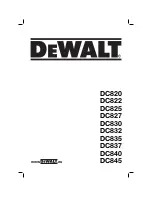
--- 4 ---
6-2. Points Requiring Special Attention During Sales Promotion
The customer should be advised of the following points during sales promotion of the Charger.
6-2-1. Charging May Not Be Possible When the Storage Battery Temperature Is High
Charging may not be possible if the temperature of the battery is 40 ˚C (104 ˚F) or higher after it has been
exposed to direct sunlight for a long time or immediately after it has been used. In such cases, the customer
should be advised to place the battery in the shade with good airflow, and allow it to cool sufficiently prior to
recharging. This condition is common to all existing chargers (both Hitachi's and competitor's models) which
employ temperature sensitive devices to terminate charging. The cooling period required before charging varies
from a few minutes to about 30 minutes, depending on the length of time the battery was used and the ambient
temperature.
6-2-2. If the Ambient Temperature or Power Supply
Voltage Is Low, Charging Time May Be Longer
The charging time for UC 9SD is greatly influenced by
the ambient temperature and input power supply
voltage.
The relationship between input power supply voltage
and charging time is shown in Fig. 1.
If the input power supply voltage is high, charging
takes less time; if low, it takes more time. Be sure to
advise the customer to charge the batteries at the
ambient temperature specified in the Handling
Instructions and at the rated voltage listed on the
nameplate.
100
90
80
70
60
50
40
30
20
10
0
(minutes)
Charging time
Ambient temperature
10 C (50 F)
20 C (68 F)
Storage battery: FEB 9S
95 % of
rated
voltage
Rated voltage
(Voltage listed
on nameplate)
105 % of
rated
voltage
Input power supply voltage
Fig. 1 Relationship between input power supply
voltage and charging time

































